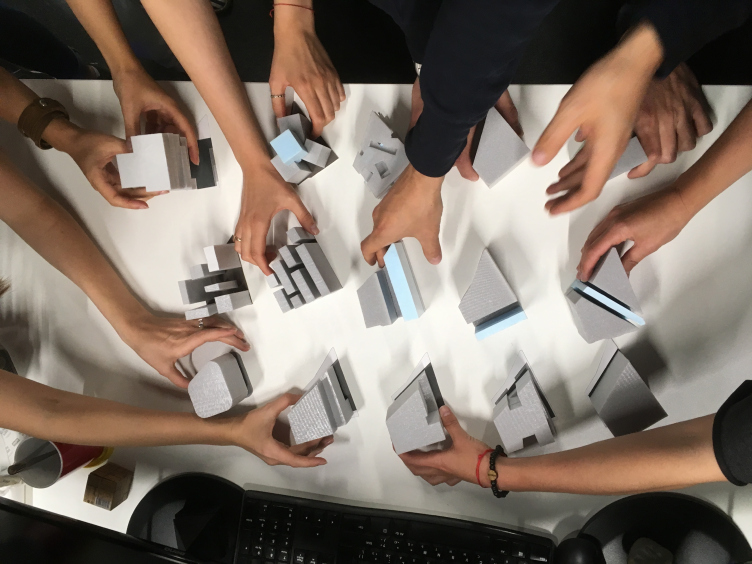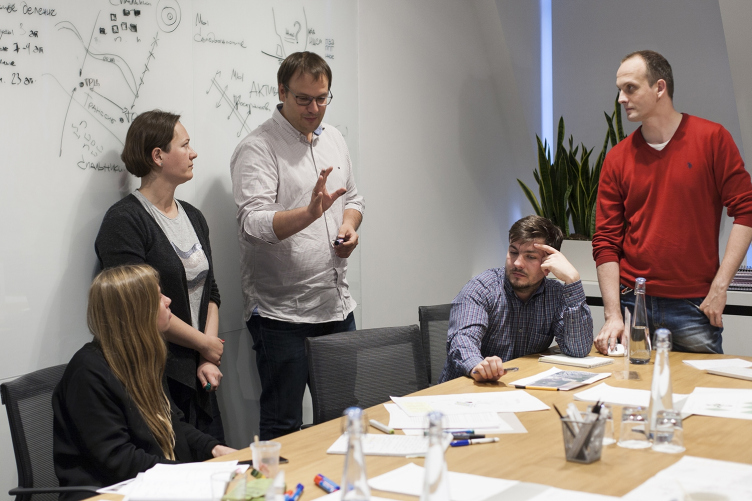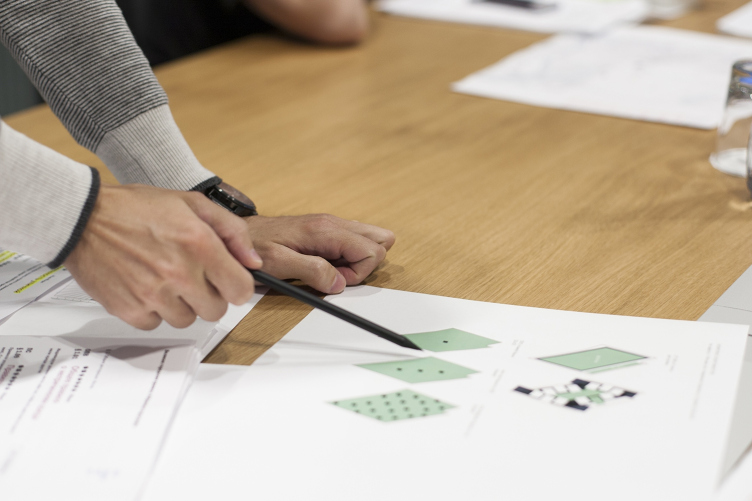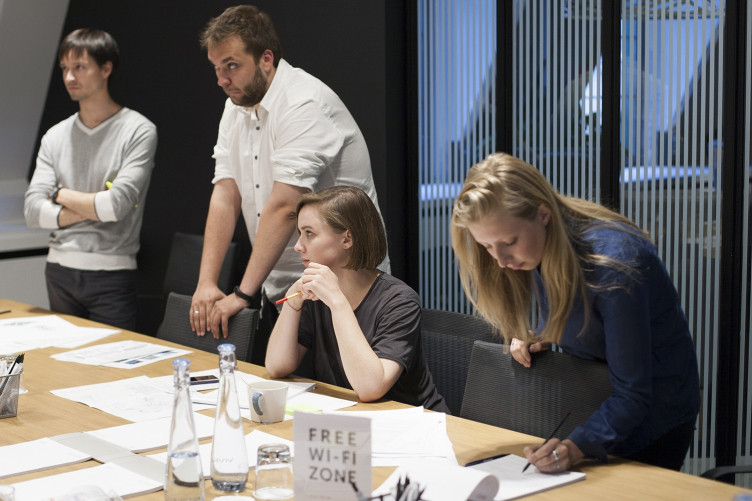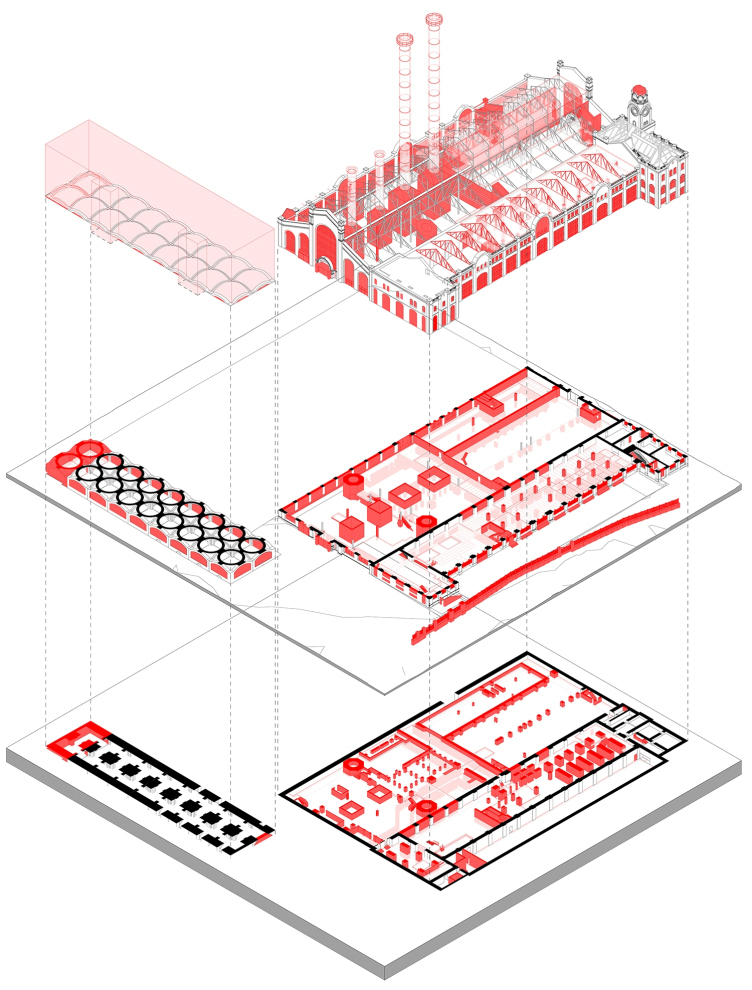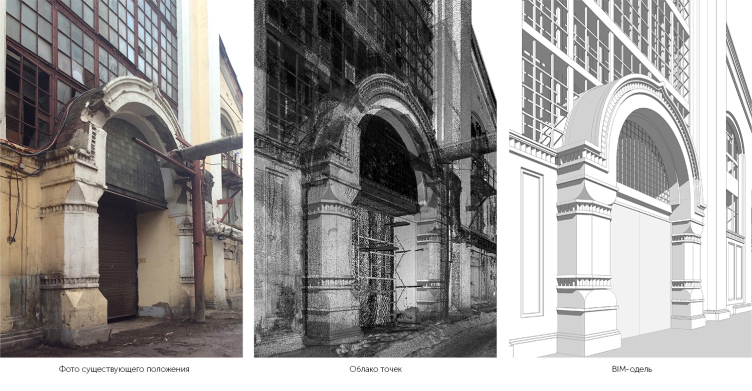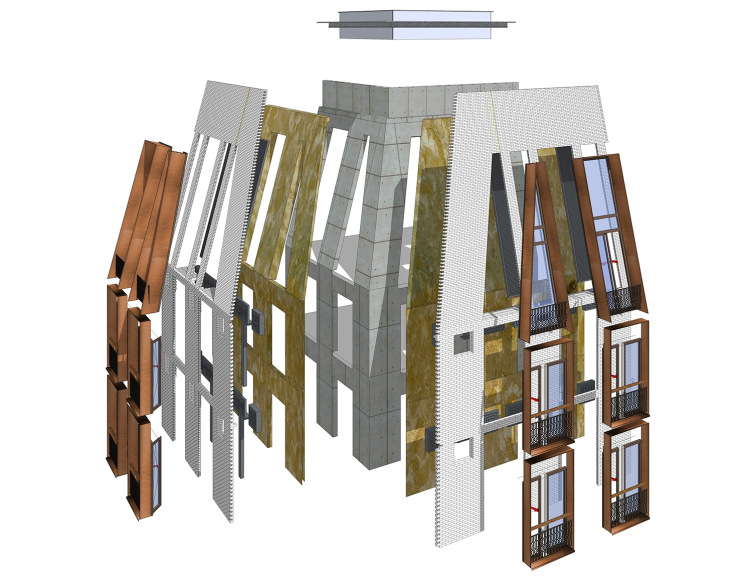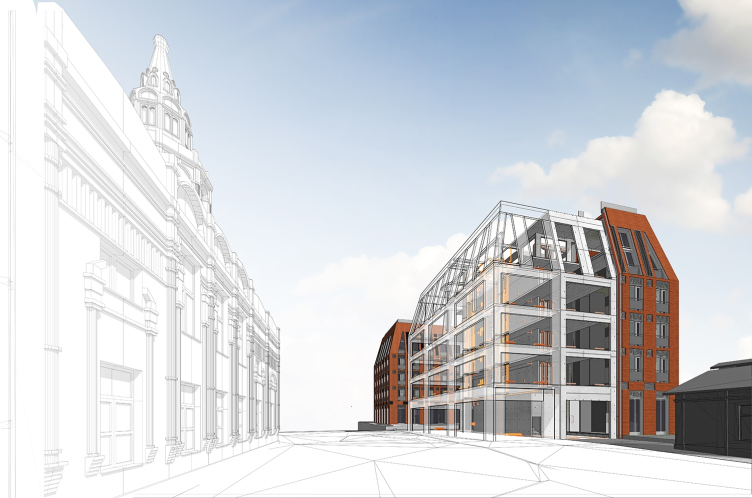
Searching for the form © APEX project bureau
Archi.ru
– I would like to start our conversation from getting a clear idea of what subject you are teaching here. Just what is “Creative Building Information Modeling” all about? I have always thought that building information modeling is a purely practical technology and there’s nothing “creative” about it – rather, it can be used for turning your architectural project into the working documents.
Andrew Dermeiko:
– Our goal is to demonstrate how the creative process of developing your architectural proposal or concept, and the purely technical process of preparing the working documents, can be tied in with each other. Our course is focused on the designed project, and, accordingly, the new possibilities that the contemporary software yields will be studied in terms of their necessary practical application to the ideas that will be generated by the students. Consequently, the research and the choice of the right type of software will go a long way to prompt new directions for developing the concept.
As a consequence of the marketing policy conducted by vendors and producers of software, as well as because of the inconsistency of the online information, people are getting an impression that BIM is “some kind of software”. In reality, however, BIM is essentially a technology that consists of a range of software products, which allow the user to work with this technology, this range being rather broad. And what we want to do is examine, within the framework of our course, various computer programs, so that our students, developing this or that architectural model, could then forward the materials directly to the construction company: to the contractor and to the manufacturer.
The working process © APEX project bureau
The working process © APEX project bureau
Ivan Anokhin:
– To us, the BIM environment is a single space for creativity, a virtual world, in which all of the stakeholders of the process coexist on a win-win basis. Our course does not provide for studying all these programs as a mere set of tools; what it is meant to do is simulate the operation of a project group: from the concept stage to cuttint the ribbon at the inauguration of a new building. Precisely because of that we first do a short intensive about implementing BIM into a project firm. At the same time, it is still true that, in terms of “rigor” of this technology, the requirements for the digital hygiene of this environment are very strict – this is not your Autocad or a paper sheet, upon which you can draw a plan and then copy it to verify it against some other layout. We will try to show the principles of working in such conditions on the basis of the experience accumulated by APEX not only in project design but also in project management, and remote interaction between the colleagues, including international communications.
The working process © APEX project bureau
– As I understand, this is the approach, thanks to which your company operates on the market so effectively. So, why are you going to teach others your “secrets of the trade” that help you get an upper hand over your competition?
Olga Lebedeva:
– APEX is a versatile company, and this educational branch is yet another stage of our development and widening the set of our skills. At the expense of this course, our employees get involved with educational activities: reading lectures, developing the course programs, teaching as such, and participating in the intermediate exhibitions as members of the judging panel...
Andrew Dermeiko:
– In addition, this is a means of influencing the information field, an opportunity to move our branch and economics forward, however posh this may sound.
Ivan Anokhin:
– To us as an actively developing company it is interesting to broaden our horizons in the modern technologies and share our knowhow with our fellow tradespeople. Such an educational product is unique on the market.
Olga Lebedeva:
– Among other things, this course is also an opportunity for us to widen our employee base, having provided the education and the basis for the team work. Meaning – you can always improve your knowledge of software but the understanding of the process from beginning to end and the ability to work with a team and the production are the really valuable skills of the employees.
GES-2. Exploded view of the dismantled and preserved parts of the building © APEX project bureau
– What is your personal motivation for developing and implementing this course?
Ivan Anokhin:
– I’ve been doing art projects for years, and I’ve been taking part in educational seminars. It’s interesting to me to apply my experience in the BIM format which allows you to create high-technology projects.
Andrew Dermeiko:
– To teach is to learn twice over; you get your own mind straight. This is an extra occasion to sort things out in your head. Besides, it’s been a long time since I taught outside of APEX, and I need to learn what the market is doing, including for correcting the course of the company.
– Olga, as far as I know, you do not have teaching experience, don’t you?
Olga Lebedeva:
– Not within the framework of a higher educational institution, I don’t, but I’ve been thinking about starting it for a long time. Within the framework of one firm, this a constant process of learning things and sharing your knowledge with your team. I’ve accumulated a formidable experience; over the 14 years of my career I have worked in many large Moscow-based firms, I studied at the Columbia University, I saw and personally experienced a huge variety of working and teaching methods. I want to do some sharing now.
I’m also fascinated by the idea of demonstrating, in such a short span of time, the whole working process from idea to implementation – because usually this takes up more than a year, and with large-scale projects even several years. I want to show that every working stage – a concept, a project, documentation draft, production and construction – everything is interesting and you can enjoy this process.
The temptation of using a large number of computer programs, especially at the end, when you play the role of the client – this is also not the last of my incentives. And, of course, the opportunity for implementing your project in collaboration with some serious partners who are ready to provide you with the best materials and top-quality production – something you could only dream of. Hadn’t I been one of the coauthors of the course, I would sign up for it myself.
GES-2. The transformation of laser scanning into a BIM model © APEX project bureau
– Andrew mentioned a broad range of products that constitute the BIM environment. How many of them are there, and what percentage are you using in your course?
Andrew Dermeiko:
– There is an international nonprofit organization Building Smart, which develops and supports IFC, a universal neutral exchange format that ensures compatibility of software products in the BIM environment. At their website, there is a complete list of all the programs that are certified to work with this format. Currently, this list includes more than 50 positions, and it’s being constantly renewed and updated. Plus, there is a certain typology: some programs are created for designing, i.e. for creating information, others – for the analysis thereof, still others – for managing and transforming this information, and so on.
A housing complex at the Dolgorukovskaya Street. BIM model with fiber mapping of the elements of the building © APEX project bureau
Ivan Anokhin:
– It is worth mentioning that besides specialized software, there are programs that can be also plugged into this environment, for example, the good old Excel. It fits in very nicely and it comes in handy for parametrizing, information retrieval, and making description.
A housing complex at the Dolgorukovskaya Street. Exploded view of the layers of the facade © APEX project bureau
Andrew Dermeiko:
– And it also allows the user to submit the information in a client-friendly format. And this is very important. And we are speaking not only about the programs but also about the team work, ways of exchanging information, getting, generating, and managing it. There is a whole bunch of scenarios.
In our course, we are planning to touch upon seven or eight programs.
– The mentioning of the very notion of information appeals to me as a journalist. However, doesn’t this sound a little too abstract for a casual listener in terms of architecture as a material object consisting of windows, doors, and bricks?
Andrew Dermeiko:
– But these also cannot exist without parameters! Actually, when we do a classic hand-drawn draft, what we see is a bunch of lines, and how we read them only depends on our interpreting this set of lines as a wall, this other set of lines as a door jamb, and so on! What fills them with meaning? Yes, one’s ability to read: somebody put this information on the list, and somebody else deciphered it.
Ivan Anokhin:
– What makes the informational model of a building different from a draft is the fact that we can operate not only the three dimensions but also such parameters as time, financial model, and whatnot. If the model is properly fine-tuned, it is possible to retrieve rather large data files – from specifications or layouts of non-typical elements to cost sheets and time graphs.
A perspective view created on the basis of the BIM model of the housing complex at the Dolgorukovskaya Street © APEX project bureau
– Judging by your descriptions, BIM as a technology has already established itself as a self-sufficient environment, and we shouldn’t hold our breath for it to change the architectural world completely. Or am I wrong, and the innovative potential of this environment is far from exhausted?
Andrew Dermeiko:
– On the one hand, nobody is talking about any new groundbreaking new-age software, and the competition is mostly based on fine-tuning minor details. On the other hand, if we are to speak about BIM’s influence on architecture, the transformation of the construction stage is only just beginning: the use of 3D printers, construction robots, and more. BIM as a database contains a far greater potential for the future automation of construction than the good old draft. Although it won’t happen overnight, we are in for some quite interesting changes.
– What if BIM suddenly disappears? Will it make your architecture any different?
Olga Lebedeva:
– My architecture will hardly be different. Back in my college years, I would do quite sophisticated projects without any computer until my fifth year. Of course, if BIM is suddenly gone, all of the mathematical calculations will be a lot harder to make – but I will draw more, enjoy the process of tracing plans with my own hands, and the number of unnecessary drafts will shrink dramatically. And, of course, there will be more building models.
As for the architecture of a project bureau, large complexes, large scales, large reconstruction projects and engineering structures – yes, all of these things do depend on the speed of processing and putting out the documentation, on the amounts of data processed, on the high precision of drafts of all the complementary sciences, and a single base of all of the stakeholders. And here you cannot imagine such a process without the BIM environment. Such architecture will simply cease to exist because the whole process will be so stretched in time that it will become no longer feasible.
Ivan Anokhin:
– Generally, my architecture will remain the same. An architectural image is first of all the result of who we are – it is born in our minds, in our imagination. At the moment, the process of working with paper only refers to the initial stages of forming the image.
The computer provides you with quite a broad set of tools to test your ideas for sustainability. Here is another question, though: the digital technologies dramatically shorten the designing time frames, which is not always a good thing, by the way. On the one hand, BIM speeds up your work, and this is one of the requirements of the market. On the other hand, speeding up your working process is not at all always a synonym for efficiency and effectiveness. A healthy balance is necessary. In fact, finding this balance between the amounts of time invested into forming the image, filtering out the ideas, thinking about how each unit would work and about the technology of the entire process – all of that would answer your previous question about the development prospects. New Shukhovs and Shekhtels must come around.
If BIM disappears I will happily fall back on my pencil but I’ll still be missing the freedom of abstract form making and the simplicity of solving routine tasks.


